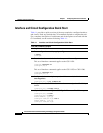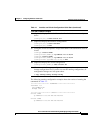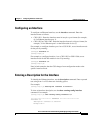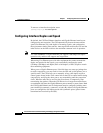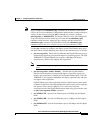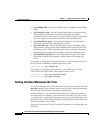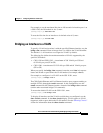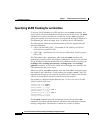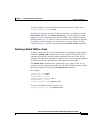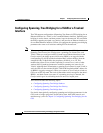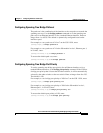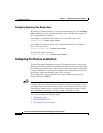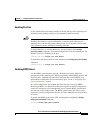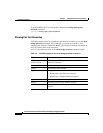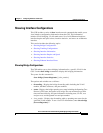
Chapter 1 Configuring Interfaces and Circuits
Configuring Interfaces
1-12
Cisco Content Services Switch Routing and Bridging Configuration Guide
OL-8241-02
Specifying VLAN Trunking for an Interface
To activate VLAN trunking for a CSS interface, use the trunk command. You
specify all VLANs that include the specified port as part of the VLAN. The trunk
command also converts the link in to a trunk link. Use the vlan command to
specify the number of each VLAN to be associated with the Gigabit Ethernet or
Fast Ethernet port. Enter an integer from 1 to 4094 as the VLAN identifier.
The following list defines the maximum number of VLANs supported by the
specific CSS models:
• CSS 11501 and CSS 11503 - A maximum of 256 VLANs per CSS and
64 VLANs per port (FE or GE)
• CSS 11506 - A maximum of 512 VLANs per CSS and 64 VLANs per port
(FE or GE)
The CSS software has a dependency when using the trunk command. For
trunking to be enabled, all VLAN bridging commands for any active VLAN must
first be disabled for the Gigabit Ethernet or Fast Ethernet interface by using the
no bridge vlan, no bridge port-priority, no bridge state, and no bridge
pathcost commands. If you do not disable VLAN bridging on an interface, the
CSS software instructs you to do so.
When you specify the trunk command, enter the word vlan in lowercase letters
and include a space before the VLAN number (for example, vlan 2). The CSS
automatically prompts you to create the specified VLAN (where y instructs the
software to create the VLAN and n cancels the VLAN creation).
For example, to configure Gigabit Ethernet port 1 in slot 1 for use in VLAN2,
VLAN3, and VLAN9, enter:
(config-if[1/1])# trunk
(config-if[1/1])# vlan 2
Create VLAN<2>, [y/n]:y
(config-if-vlan[1/1-2])# vlan 3
Create VLAN<3>, [y/n]:y
(config-if-vlan[1/1-3])# vlan 9
Create VLAN<9>, [y/n]:y
(config-if-vlan[1/1-9])#
The no trunk command turns off all trunking, removes all specified vlan
commands associated with the interface, and deletes this information from the
running configuration. The interface is returned to VLAN1 by default.



